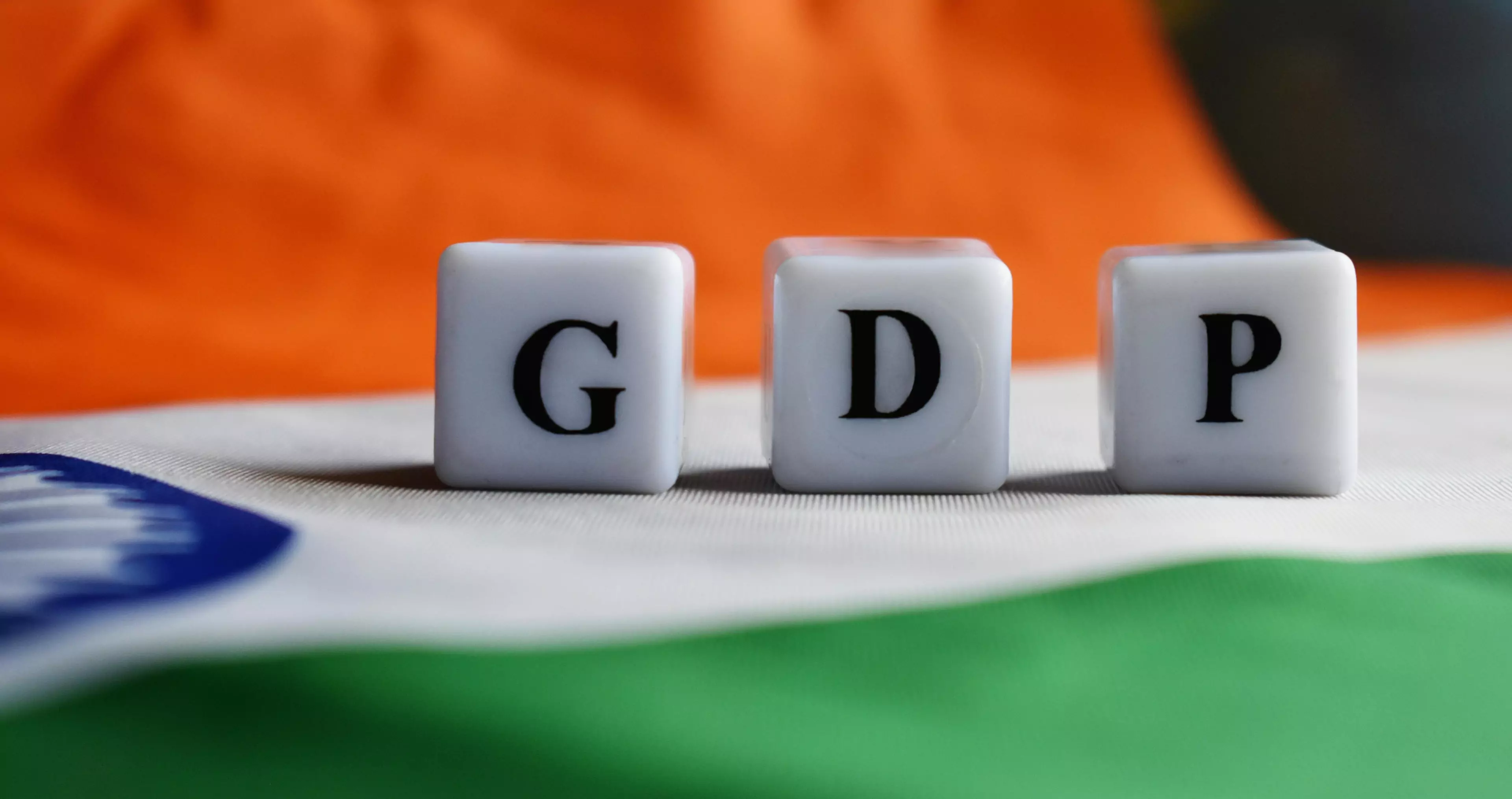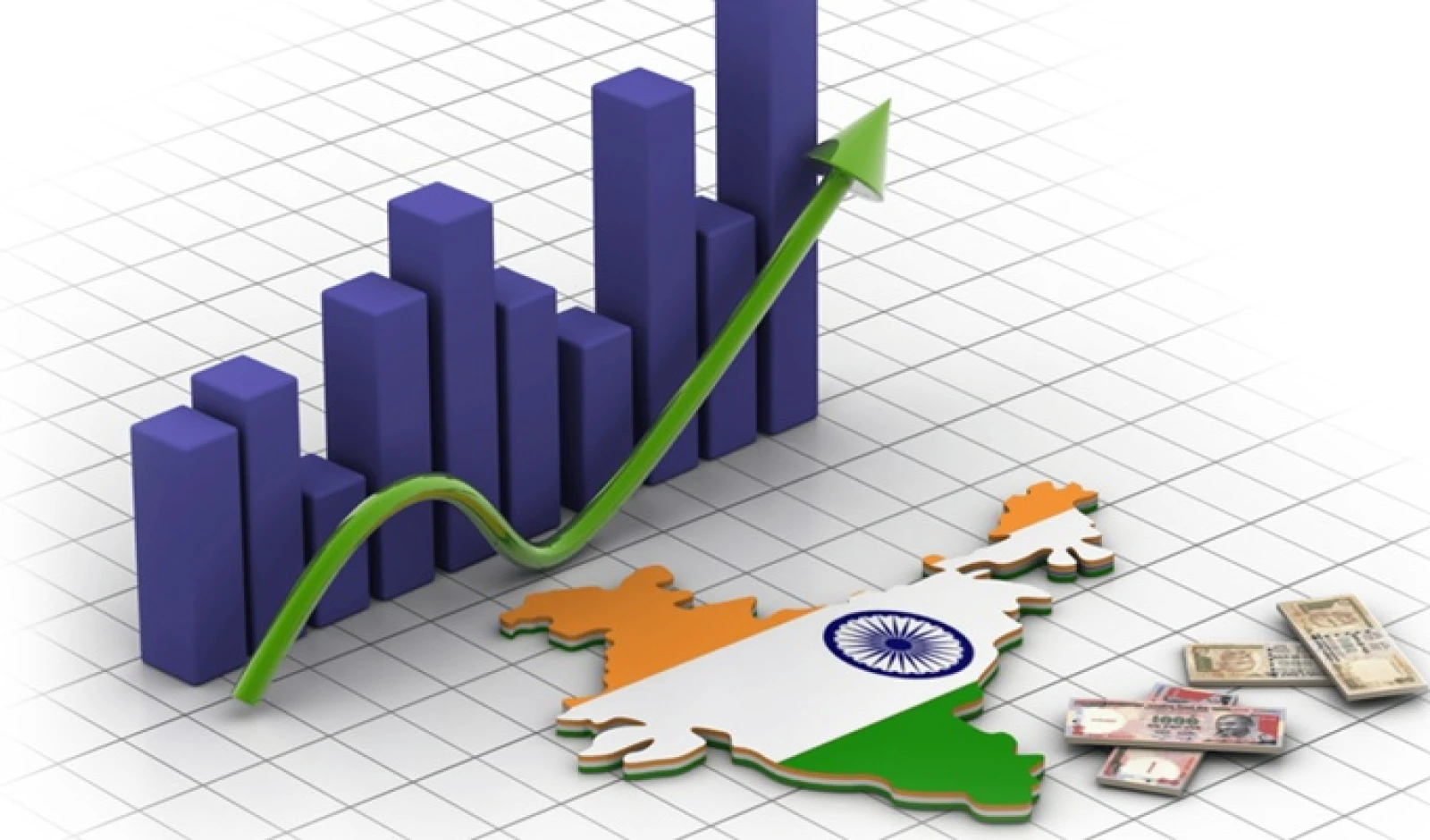India’s Economic Growth (6.4% GDP, 2024-25)
The Indian economy is projected to grow at 6.4% in FY 2024-25, as per the first advance estimates by the National Statistical Office (NSO). This reflects a deceleration from the 8.2% growth recorded in FY 2023-24, marking the lowest growth rate since the pandemic-induced contraction in FY 2020-21 (-5.8%).
This note provides a comprehensive analysis of India’s economic growth outlook for FY 2024-25, covering GDP trends, sector-wise growth, fiscal performance, inflation, trade, and key challenges.
GDP Growth Trends
- Real GDP (Constant Prices): Estimated to grow at 4% in FY 2024-25, compared to 8.2% in FY 2023-24.
- Nominal GDP (Current Prices): Expected to increase by 7%, reaching ₹324.11 lakh crore in FY 2024-25 from ₹295.36 lakh crore in FY 2023-24.
- Global Comparison: The projected 4% growth keeps India among the fastest-growing economies, compared to the IMF’s global GDP projection of 3.2%.
- Decadal Growth Trend: India’s average GDP growth rate over the last decade has been 6%, reinforcing long-term economic stability.
Key Factors Influencing GDP Growth:
- Private consumption growth (7.3% in FY 2024-25, up from 4% in FY 2023-24).
- Government spending rebound (Government Final Consumption Expenditure at 4.1%, from 2.5% in the previous year).
- Slower industrial and services sector growth, impacting overall economic expansion.
- Continued investment in infrastructure and digital transformation.
Sectoral Growth Analysis
- Agriculture Sector
- Projected Growth: 8% in FY 2024-25, up from 1.4% in FY 2023-24.
- Key Growth Drivers:
- Government support through MSP hikes, irrigation schemes, and agri-tech investments.
- Improved monsoon expectations are contributing to higher crop yields.
- Growth in livestock, fisheries, and allied sectors.
- Industry & Manufacturing
- Manufacturing GVA Growth: Expected to slow down to 5.3% in FY 2024-25, from 9% in FY 2023-24.
- Construction Sector: Continues strong momentum at 9.9% in FY 2023-24, driven by infrastructure spending.
- Industrial Share in GVA: 6% of total GVA in FY 2023-24, signaling moderate industrial expansion.
- Challenges:
- Weak global demand is affecting exports.
- High input costs are impacting profit margins.
- Services Sector
- Projected Growth: 8% GVA growth in FY 2024-25, down from 6.4% in FY 2023-24.
- High-Growth Segments:
- The financial services & IT sector continues to perform well.
- Trade, hotels, communication, and broadcasting are projected to slow down.
- Public administration, defense, and other services expected to expand at 1% (up from 7.8%), driven by government spending.
Fiscal Performance & Investment Trends
- Government Spending & Fiscal Position
- Union Government Fiscal Deficit: Reduced to 6% of GDP in FY 2023-24, from 6.4% in FY 2022-23.
- Capital Expenditure (CapEx): Increased 2% YoY to
₹9.5 lakh
crore, focused on:
- Infrastructure projects (road, rail, defense, telecom).
- State-led capital formation for long-term economic growth.
- State Fiscal Health: States’ gross fiscal deficit was 6% lower than projected, showing improved fiscal management.
- Private Investment & Business Sentiment
- Gross Fixed Capital Formation (GFCF): Increased by 8%, indicating strong private sector investment.
- FDI & FPI Trends:
- Net FPI inflows at $44.1 billion in FY 2023-24, reversing previous outflows.
- FDI inflows are stable, with a focus on the manufacturing & technology sectors.
Inflation & Monetary Policy
- Inflation Trends
- Retail Inflation (CPI) declined to 4% in FY 2023-24, from 6.7% in FY 2022-23.
- Core inflation remains stable at around 3%, ensuring price stability.
- Factors Controlling Inflation:
- Food price stabilization measures (buffer stock management, import policy adjustments).
- Fuel price cuts & LPG subsidies.
- RBI’s monetary tightening in previous years.
- RBI’s Monetary Policy Stance
- Interest rates remain steady, with no major policy rate cuts expected.
- Focus on balancing growth with inflation control to maintain economic stability.
Trade & External Sector Performance
- Export & Import Trends
- Total exports (goods + services) reached a record $341.1 billion in FY 2023-24.
- Merchandise trade weakened, while service exports remained strong.
- Net Private Transfers (Remittances): Increased to $106.6 billion, helping to stabilize foreign exchange reserves.
- Foreign Exchange Reserves & Rupee Stability
- Forex Reserves: Sufficient to cover 11 months of projected imports.
- Indian Rupee Stability: Among the least volatile emerging market currencies in 2024-25.

Employment & Social Development
- Job Creation & Workforce Growth
- India needs to generate 7.85 million jobs annually to absorb the growing workforce.
- Female labor force participation rose to 37% (from 23.3% in 2017-18).
- Social Welfare & Direct Benefit Transfers (DBT)
- ₹36.9 lakh crore transferred via DBT since 2013, improving subsidy efficiency.
- The government focuses on skill development & formal job creation to boost employment.
Challenges & Risks to GDP Growth
- Global Economic Headwinds
- Geopolitical conflicts may cause supply chain disruptions and inflation spikes.
- US & EU monetary policies impacting global capital flows and FPI in India.
- Domestic Challenges
- The slowdown in manufacturing & industrial growth is affecting job creation.
- Agriculture remains vulnerable to climate variability & water scarcity.
- Need for structural reforms in ease of doing business and labor laws.
- India’s GDP is projected to grow at 6.4% in FY 2024-25, ensuring steady economic expansion.
- Strong domestic demand, infrastructure spending, and services growth will sustain economic momentum.
- Policy focus on inflation control, fiscal discipline, and investment promotion will shape the economic trajectory.
Way Forward
- Boosting industrial growth through policy incentives.
- Enhancing ease of doing business to attract more investments.
- Strengthening trade agreements to expand export markets.
- Expanding social security programs to ensure inclusive growth.
GDP-Related Terms
Real GDP (Gross Domestic Product at Constant Prices)
- Definition: Real GDP measures the total value of goods and services produced in an economy in a given year, adjusted for inflation.
- Why It Matters: It reflects the actual economic growth by removing the effects of price changes.
- Example: If India’s real GDP grows by 4%, it means the economy produced 6.4% more goods and services in 2024-25 than in the previous year.
Nominal GDP (Gross Domestic Product at Current Prices)
- Definition: Nominal GDP is the total value of goods and services produced in an economy measured at current market prices.
- Why It Matters: It includes the impact of inflation, making it higher than real GDP.
- Example: If India's nominal GDP is ₹324.11 lakh crore in 2024-25, this includes both economic growth and inflation.
GDP Growth Rate
- Definition: The rate at which a country’s GDP increases or decreases compared to the previous year.
- Why It Matters: A high GDP growth rate means a strong economy, while a low or negative rate signals a slowdown or recession.
- Example: India’s GDP grew 2% in FY 2023-24 but slowed to 6.4% in FY 2024-25, indicating slower growth.
Sectoral Terms
Gross Value Added (GVA)
- Definition: GVA measures the total value of goods and services produced in an economy after deducting input costs (raw materials, energy, etc.).
- Formula: GVA=GDP+Subsidies−TaxesGVA = GDP + Subsidies - TaxesGVA=GDP+Subsidies−Taxes
- Why It Matters: GVA provides a sector-wise breakdown of the economy’s growth.
Manufacturing GVA
- Definition: The contribution of the manufacturing sector to the overall GVA.
- Example: If manufacturing GVA growth is 5.3% in 2024-25, it means manufacturing output increased by 5.3% compared to the previous year.
Services Sector GVA
- Definition: Measures the contribution of trade, hotels, financial services, IT, healthcare, and public administration to the economy.
- Why It Matters: Services form 7% of India’s economy, making it the largest sector.
Agriculture GVA
- Definition: The contribution of crop production, livestock, forestry, and fisheries to the economy.
- Why It Matters: Agriculture employs a large portion of the population, and its growth affects rural income and inflation.
Fiscal & Investment Terms
Fiscal Deficit
- Definition: The difference between the government’s total revenue and total expenditure.
- Formula: Fiscal Deficit = Total Expenditure−Total Revenue\text{Fiscal Deficit} = \text{Total Expenditure} - \text{Total Revenue}Fiscal Deficit=Total Expenditure−Total Revenue
- Why It Matters: A high fiscal deficit means the government is spending more than it earns, leading to higher borrowing.
Capital Expenditure (CapEx)
- Definition: Government spending on infrastructure projects like roads, railways, power, and defense that boost economic growth.
- Why It Matters: Higher CapEx leads to job creation and long-term economic benefits.
Gross Fixed Capital Formation (GFCF)
- Definition: The total investment in fixed assets (factories, machinery, buildings, etc.) by the government and private sector.
- Why It Matters: High GFCF signals strong business confidence and future growth.
Foreign Direct Investment (FDI)
- Definition: Investment by foreign companies or individuals in Indian businesses to gain ownership or control.
- Example: If Google invests in an Indian telecom company, it is FDI.
Foreign Portfolio Investment (FPI)
- Definition: Investment by foreign investors in Indian stocks, bonds, and mutual funds, without controlling ownership.
- Why It Matters: FPI flows affect stock market performance and exchange rates.
Inflation & Monetary Policy Terms
Retail Inflation (Consumer Price Index—CPI)
- Definition: The rate at which prices of consumer goods and
services
(food, housing, fuel, healthcare) increase over time.
- Why It Matters: High inflation reduces
purchasing
power, while low inflation supports economic stability.
Core Inflation
- Definition: Inflation excluding volatile food and fuel
prices, giving a clearer picture of long-term price trends.
- Why It Matters: Helps policymakers decide interest
rates.
Monetary Policy
- Definition: The RBI’s strategy is to
control
inflation, manage liquidity, and stabilize the economy through interest rates
and
money supply.
Interest Rate (Repo Rate)
- Definition: The rate at which RBI lends money to
commercial
banks.
- Why It Matters: Higher repo rates make loans
costlier, reducing inflation, while lower rates boost borrowing
and
investment.
Trade & External Sector Terms
Merchandise Exports & Imports
- Definition: Exports refer to goods sold to
foreign
countries, while imports are goods bought from other countries.
- Why It Matters: A trade surplus (exports >
imports) strengthens the economy, while a trade
deficit weakens it.
Current Account Deficit (CAD)
- Definition: The difference between a country’s
foreign currency earnings (exports, remittances, FDI) and spending
(imports,
FPI outflows, foreign debt payments).
- Why It Matters: A high CAD weakens the
currency
and increases reliance on foreign investment.
Foreign Exchange Reserves
- Definition: The RBI’s stock of foreign
currencies,
gold, and bonds, used to stabilize the rupee.
- Why It Matters: Higher reserves help India manage
trade
deficits and currency fluctuations.
Rupee Exchange Rate Stability
- Definition: How stable the Indian Rupee (INR) is
compared
to foreign currencies (USD, Euro).
- Why It Matters: A weak rupee increases
import
costs, while a stable rupee helps trade and investment.
Employment & Social Terms
Labor Force Participation Rate (LFPR)
- Definition: The percentage of the working-age
population
(15-64 years) that is actively working or seeking jobs.
- Why It Matters: A higher LFPR means more people are
contributing to the economy.
Female Labor Force Participation
- Definition: The percentage of women engaged in the
workforce.
- Why It Matters: Higher female
participation boosts
economic growth and gender equality.
Direct Benefit Transfer (DBT)
- Definition: Government subsidies and welfare
payments sent
directly to citizens’ bank accounts.
- Examples: LPG subsidy, MGNREGA wages, PM-Kisan payments.
- Why It Matters: Reduces corruption and
ensures
efficient welfare distribution.
- Definition: The difference between a country’s foreign currency earnings (exports, remittances, FDI) and spending (imports, FPI outflows, foreign debt payments).
- Why It Matters: A high CAD weakens the currency and increases reliance on foreign investment.
Foreign Exchange Reserves
- Definition: The RBI’s stock of foreign currencies, gold, and bonds, used to stabilize the rupee.
- Why It Matters: Higher reserves help India manage trade deficits and currency fluctuations.
Rupee Exchange Rate Stability
- Definition: How stable the Indian Rupee (INR) is compared to foreign currencies (USD, Euro).
- Why It Matters: A weak rupee increases import costs, while a stable rupee helps trade and investment.
Employment & Social Terms
Labor Force Participation Rate (LFPR)
- Definition: The percentage of the working-age population (15-64 years) that is actively working or seeking jobs.
- Why It Matters: A higher LFPR means more people are contributing to the economy.
Female Labor Force Participation
- Definition: The percentage of women engaged in the workforce.
- Why It Matters: Higher female participation boosts economic growth and gender equality.
Direct Benefit Transfer (DBT)
- Definition: Government subsidies and welfare payments sent directly to citizens’ bank accounts.
- Examples: LPG subsidy, MGNREGA wages, PM-Kisan payments.
- Why It Matters: Reduces corruption and ensures efficient welfare distribution.













